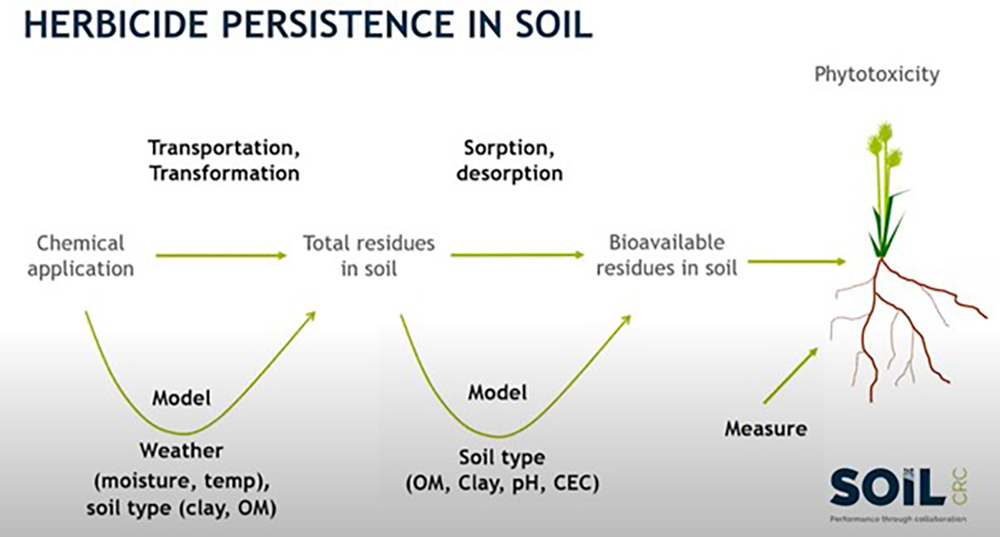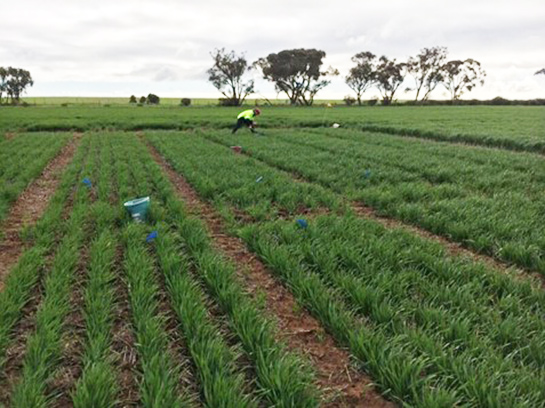This fact sheet supports the ‘Herbicide residue in soils’ webinar presented by Soil CRC Researcher Dr Michael Rose (previously NSW Department of Primary Industries, now with Southern Cross University).
In this webinar, Dr Rose highlights the research and development of tools to better manage herbicide residues in soil, focusing on the persistence of herbicides in soil and the toxicity to crop plants.
How does herbicide residues in soils affect crop production?
The loss of crop productivity resulting from herbicide residues in soils is difficult to accurately determine, due to the complexity and lack of tools to quantify herbicide damage. However, it is thought to be significant, particularly in sandy soils.
Herbicides are a valuable tool for controlling weeds and realising crop yield potential. Currently, herbicide label guidelines are general and unable to account for the combinations of soil types and weather conditions that can affect herbicide persistence in soil.
Herbicide residues in soils can limit crop performance if not managed correctly. It is difficult for growers and advisors to diagnose whether poor crop growth is caused by herbicide residues or by other environmental stresses, such as nutrient deficiency, moisture stress/drought or pest damage.
How long do herbicides persist in soil?
Understanding the degradation and persistence of herbicides in soil is crucial for effective management and environmental protection, with factors such as soil characteristics and weather conditions influencing the process.
Research efforts aim to develop models that predict herbicide concentrations in soil based on application rates, soil type, and weather conditions, providing growers and consultants with valuable tools for decision-making.
The impact of soil organic matter, microbial activity, clay content, and cation exchange capacity on herbicide persistence is being analysed to improve our understanding. The effect of pH, especially in calcareous soils, on the persistence and bioavailability of herbicides is being studied.

Guiding herbicide use with toxicity thresholds
Developing toxicity thresholds can help guide herbicide use decisions, considering differences in residual activity across soil types. Spatial variation in herbicide residues within the soil profile and across the field presents challenges, requiring careful soil sampling strategies for accurate assessments.
Ensuring accuracy in herbicide residue analysis
When sending soil or plant tissue for analysis, it’s crucial to enquire about the limits of detection and methods used by the lab. This ensures accurate results, particularly for herbicides active at low concentrations, where standard high-throughput testing methods may not detect residues effectively. By understanding the detection limits and methodologies employed, growers and consultants can make more informed decisions regarding herbicide management.

Birchip Cropping Group trial site
Further information
- GRDC Update 2022: Soil and plant tissue testing for herbicide residues – how can it help
- Publication: Herbicide residues in Australian grain cropping soils at sowing and their relevance to crop growth (ScienceDirect)
- GRDC Update 2021: Residue watch how do I know if herbicide residues are breaking down before sowing
Acknowledgement
This fact sheet was published as part of the ‘Building technical capacity for improved soil management’ project. It was produced by the Soil CRC and jointly funded through the Australian Government’s National Landcare Program.
Posted Apr 18, 2024

